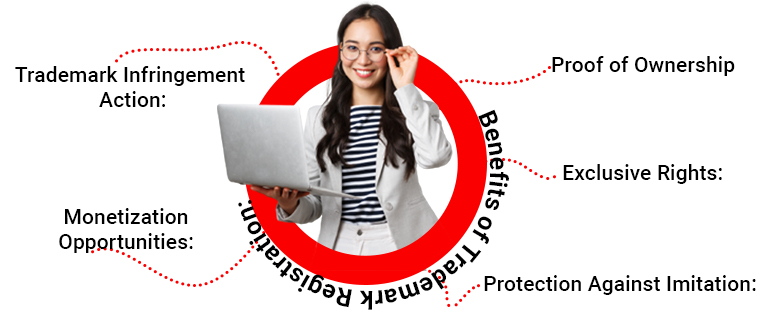In the dynamic and fiercely competitive realm of business, crafting a distinctive brand is more than just a design exercise – it is a strategic imperative for success. A brand is the encapsulation of your business’s identity, products, and reputation. It is the symbol that resonates with your customers, distinguishes you from competitors, and leaves an indelible mark in the minds of consumers. Beyond a mere logo, your brand is a powerful asset that encapsulates the essence of your enterprise.
Recognizing the paramount importance of this intangible asset, safeguarding your brand becomes a strategic necessity. This is where the pivotal role of trademark registration comes into play. Trademark Registration in Canada is a proactive and indispensable measure to secure exclusive rights to your brand elements, providing a legal shield against potential infringers and counterfeiters. It is the formalized process through which a business seeks protection for its brand name, logo, slogan, or any distinctive identifier associated with its products or services.
Understanding Trademarks:
A trademark is more than a symbol; it’s a legal tool that grants exclusive rights to use specific words, phrases, designs, or business names associated with your brand. When you register a trademark, you ensure that only your business can use those identifiers in connection with your products or services.
This comprehensive guide aims to demystify the process of Canada trademark registration for businesses operating there. Navigating through the intricacies of the Canadian trademark system, this guide will elucidate the steps, requirements, and benefits of trademark registration. From conducting a thorough trademark search to identify potential conflicts to determining the appropriate trademark classes, filing the application, and responding to any objections during the examination – each step is a critical building block in the journey towards securing your brand’s legal foundation.
Read also this -: Quick guide for Trademark Registration in Canada
In the Canadian business landscape, where innovation and creativity thrive, the significance of trademark registration cannot be overstated. It not only grants exclusive rights to the trademark owner but also serves as a deterrent to potential imitators. With the exclusive rights conferred by registration, businesses can confidently invest in building brand equity, knowing that their unique identifier is legally protected.
As we delve into the intricacies of trademark registration in Canada, it’s essential to understand the broader implications for your business. A registered trademark enhances your brand’s credibility, instills consumer trust, and establishes a valuable asset that can appreciably contribute to your enterprise’s overall valuation. This guide will serve as your companion, providing insights, practical tips, and a step-by-step roadmap to navigate the trademark registration journey, ensuring that your brand is not just a symbol but a legally fortified cornerstone of your business success in the Canadian market.
What can be trademarked?
Almost anything that distinguishes your business, such as colours, slogans, and names, can be trademarked. However, it must be specific to your brand and not too similar to existing trademarks in the same class of goods and services.
Benefits of Trademark Registration:

1. Proof of Ownership: Obtaining a certificate of Canada Trademark Registration serves as conclusive legal evidence that you are the rightful owner of the trademark. This certificate is akin to a deed for real estate, providing irrefutable proof of your exclusive rights to use the registered mark in connection with the specified goods or services. This proof of ownership is invaluable in legal proceedings and disputes, establishing your legitimate claim to the trademark.
2. Exclusive Rights: Trademark registration in Canada grants you exclusive rights to use your branding for selling products and services within the country. This exclusivity is effective for a period of 10 years, providing a substantial time frame during which your brand is protected from unauthorised use. Importantly, this protection is renewable indefinitely, allowing you to maintain exclusive rights over your trademark for as long as you continue to renew the registration.
3. Protection Against Imitation: A registered trademark in Canada serves as a powerful deterrent against competitors attempting to create similar trademarks that could potentially confuse your customers. With exclusive rights granted by registration, you have a legal basis to prevent others from using marks that closely resemble yours, safeguarding your brand’s distinctiveness and preventing dilution of its unique identity in the marketplace.
4. Trademark Infringement Action: The Trade-marks Act empowers trademark owners to take legal action against those attempting to use their registered trademark in Canada without authorization. If infringement occurs, you have the right to pursue legal remedies, including seeking damages and injunctive relief. This legal recourse is a crucial tool for maintaining the integrity of your brand and protecting it from unauthorized use that could harm your business.
Read also this -: Trademark registration in United States
5. Monetization Opportunities: Beyond mere protection, a registered trademark in Canada opens up monetization opportunities for your business. You can license your trademark to third parties for various commercial purposes, such as franchising, merchandising, or collaborations. This not only expands your brand’s reach but also creates additional revenue streams for your business. By leveraging your registered trademark in strategic partnerships, you can enhance the overall value and profitability of your brand.
Business Name vs. Trademark Registration
While a legal business name is used to identify a business, it does not protect your products or services. Canada Trademark Registration is a strategic decision to prevent imitation and secure your brand identity.
Business Name Registration: Legally required if operating under a name different from the legal entity owning the business. It doesn’t provide the benefits of a registered trademark.
Trademark Registration: Essential for protecting your ownership of products or services, preventing competitors from duplicating your brand.
Submitting a Trademark Application in Canada:
Trademarking is a meticulous process that takes 15 to 18 months for a trademark examiner to review your application. Follow these steps when submitting your application to the Canadian Intellectual Property Office (CIPO):
1. Attach a Representation: When submitting a trademark application to the Canadian Intellectual Property Office (CIPO), it’s crucial to include a clear representation of the trademark. This can be a visual depiction, such as a logo or stylized text, accompanied by a description if necessary. The representation helps the CIPO understand and identify the distinctive features of your trademark, ensuring accurate examination and registration.
2. Goods and Services Explanation: Clearly outlining the goods and services associated with your trademark is a fundamental step in the application process. The description should be precise and detailed, providing a comprehensive understanding of the products or services connected to the mark. Accurate classification of goods and services according to the Nice Classification system is crucial for proper registration and protection.
3. Evidence of Use: While not mandatory at the time of filing, providing evidence of the trademark’s use in Canada strengthens your application. This can include samples of packaging, promotional materials, or invoices showing the extent and duration of the trademark’s use. This evidence supports the distinctiveness and legitimacy of your trademark, increasing the likelihood of a successful Canada Trademark Registration.
4. Government Fee: To initiate the Canada trademark registration process with CIPO, applicants are required to pay a government filing fee. As of the last update, this fee is $330 for one class of goods and services. It’s important to note that if your trademark falls under multiple classes, an additional fee of $100 is incurred for each additional class. Ensuring prompt and accurate payment of these fees is essential to proceed with the examination process.
Navigating these steps diligently and accurately is crucial for a smooth and successful trademark registration process in Canada. The meticulous preparation and submission of the trademark application contribute to its clarity and strength, increasing the likelihood of approval by the CIPO examiner. Additionally, providing evidence of use underscores the legitimacy of your trademark, while timely payment of government fees ensures the continuous progression of the application through the thorough review process, which typically takes 15 to 18 months for a trademark examiner to complete.
Top 3 Things to Remember with Trademarks:
1. Distinguish from Patents and Copyright: Trademarks, patents, and copyrights protect different intellectual property assets. Understand the distinctions.
2. Active Use Requirement: Regularly use your registered trademark for promotion. Inactivity may lead to removal from the Trademark Register.
3. Trademarking Trade Names: Trademark your specific names for products or services to protect your business.
What You Can’t Register as a Trademark
The Trade-marks Act prohibits certain registrations, including names and surnames, clearly descriptive or deceptively misdescriptive marks, place of origin, words in other languages, and confusingly similar trademarks.
What Happens Next?
After filing, it takes 12-14 months to receive a response. CIPO will advertise your trademark in the Canadian Trademarks Journal, allowing others to oppose it within two months. If unopposed, your trademark proceeds to registration, concluding the 18-24 month process.
In conclusion, registering a trademark is a strategic investment in safeguarding your brand’s identity and ensuring exclusive rights. While the process may seem intricate, the benefits, including legal protection and monetization opportunities, make it a valuable step for any business. Consider consulting a qualified trademark agent for expert guidance throughout the process. Your brand is your asset; protect it with a registered trademark in Canada.

